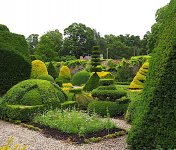A splendid Elizabethan Mansion built around a C14th pele tower.
Levens Hall is a splendid Elizabethan house in the valley of the River Kent and surrounded by rich farmland.
The original building dates from C13th, when the Redman family built a pele tower here as a defence against the Scots.
The estate was sold to Alan Bellingham in 1562. The pele tower was in poor condition and he was responsible for rebuilding and extending the building. Only the base of the pele tower survived.

The building was turned into a comfortable family home, with panelling and plaster ceilings. He employed some of the best Italian plasterers. The family were fiercely loyal to Elizabeth I and her coat of arms can be seen throughout the house.
The house and estates passed to Colonel James Grahme in 1688. There is a story that the last Bellingham owner not only gambled his fortune away, but also risked his house and estate on a single turn of the cards, and lost. The rainwater heads on the exterior of the house are decorated with the symbol of a single heart, said to represent the ace of hearts that won the Levens estate for Col. Grahme.
Grahme was responsible for asking Guillaume Beaumont to redesign the park and gardens, turning the medieval deer park into the latest fashion garden with clipped evergreens and hedged enclosures. The gardens still maintain their original layout and are one of the few Elizabethan designs to survive. The topiary garden was planted in 1694 and many of the original trees still survive. It is the oldest topiary garden in the world.
The estate remained in the Grahme family, passing through marriage to the Howard Family and then to the Bagot family, who own it now.
Mary Wellesley, the favourite niece of the Duke of Wellington married a Bagot and there is a lot of Wellington memorabilia in the house which was left to her in Wellington’s will.
The main entrance is flanked by a stone pillars topped with pineapples.
The drive continues across the front of the house to the service courtyard to the west of the hall. This is now the Levens Kitchen
A short flight of stone steps leads up to the main entrance and the four storied pele tower is to the right.

Website
Floor plan
Cont...
Levens Hall is a splendid Elizabethan house in the valley of the River Kent and surrounded by rich farmland.
The original building dates from C13th, when the Redman family built a pele tower here as a defence against the Scots.
The estate was sold to Alan Bellingham in 1562. The pele tower was in poor condition and he was responsible for rebuilding and extending the building. Only the base of the pele tower survived.
The building was turned into a comfortable family home, with panelling and plaster ceilings. He employed some of the best Italian plasterers. The family were fiercely loyal to Elizabeth I and her coat of arms can be seen throughout the house.
The house and estates passed to Colonel James Grahme in 1688. There is a story that the last Bellingham owner not only gambled his fortune away, but also risked his house and estate on a single turn of the cards, and lost. The rainwater heads on the exterior of the house are decorated with the symbol of a single heart, said to represent the ace of hearts that won the Levens estate for Col. Grahme.
Grahme was responsible for asking Guillaume Beaumont to redesign the park and gardens, turning the medieval deer park into the latest fashion garden with clipped evergreens and hedged enclosures. The gardens still maintain their original layout and are one of the few Elizabethan designs to survive. The topiary garden was planted in 1694 and many of the original trees still survive. It is the oldest topiary garden in the world.
The estate remained in the Grahme family, passing through marriage to the Howard Family and then to the Bagot family, who own it now.
Mary Wellesley, the favourite niece of the Duke of Wellington married a Bagot and there is a lot of Wellington memorabilia in the house which was left to her in Wellington’s will.
The main entrance is flanked by a stone pillars topped with pineapples.
The drive continues across the front of the house to the service courtyard to the west of the hall. This is now the Levens Kitchen
A short flight of stone steps leads up to the main entrance and the four storied pele tower is to the right.
Website
Floor plan
Cont...

